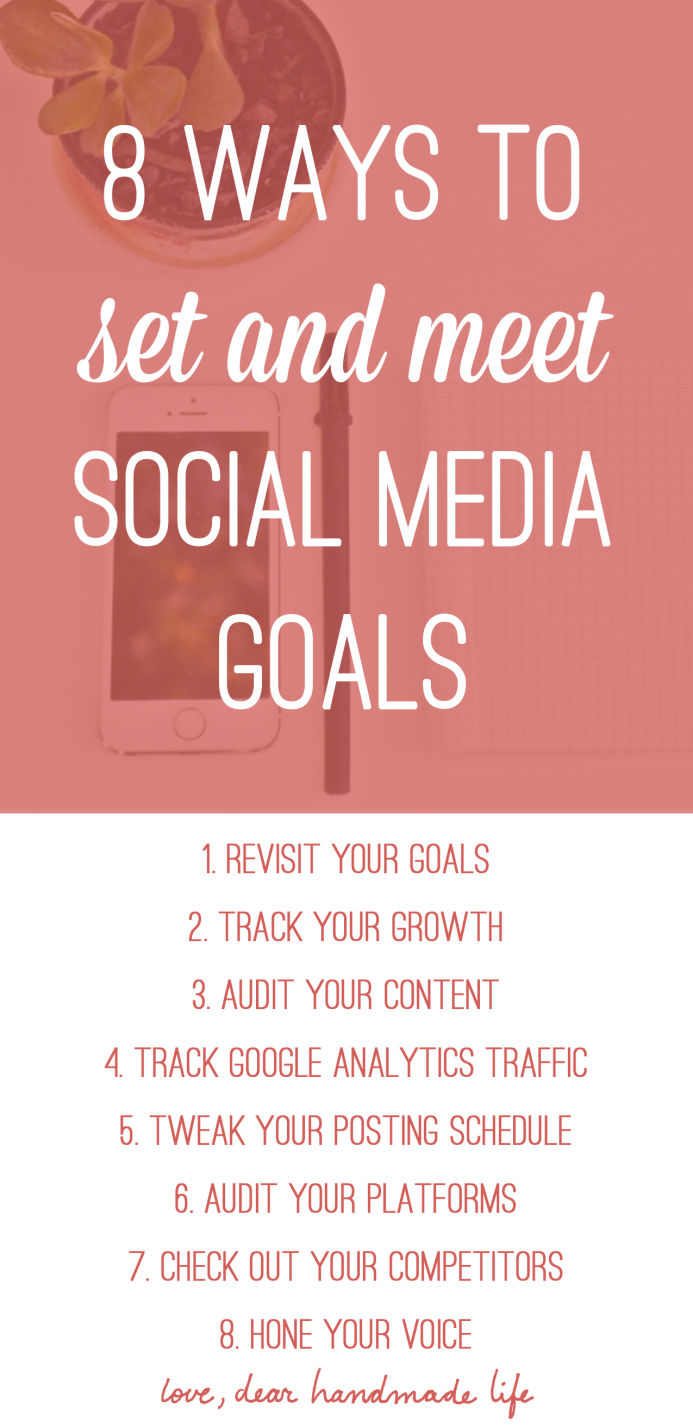8 ways to make the most out of your social media
Editor’s Note: Be sure to check out more awesome insights from Meighan O’Toole in this episode of our podcast where she shares her insights on social media trends and advice on being authentic online.
Part of creating a solid, consistent social media presence is ensuring it represents your business. It should be an ever-evolving process that is constantly refined, checked-in on, and cared for. Having a social media presence is not a set it and forget it situation.
As small business owners with so much on our plates, it’s so easy to let some things go once we find that sweet spot. Social media can be overwhelming and confusing, so once you “Get it!,” often times the urge is to just put it on auto pilot; continue to post, check notifications, and only change things up when there are big announcements about a new platform.
While I completely understand why this happens, it’s not helping you use social media in a way that can further your goals. As with anything else in life, your actions should line up with achieving your goals. (If you haven’t set social media goals yet, start here now.) It’s imperative to keep your social media strategy vibrant and robust. You do this by checking in on your growth, activity, overall online presence, and continuing to adjust things as needed as well as reviewing your performance as you go. A great time to do this is at the end of each month, so you can evaluate everything you have done and make adjustments for the following month.
Today, we’re going to go over the main areas and actions you should be checking in on monthly (or at the very least quarterly) to make sure your social media strategy is moving in the direction of your goals, continues to represent your business in a way you can truly feel proud of, and is performing and returning on investment in the way it should.
1. Revisit Your Goals
Setting social media goals is absolutely imperative, but just like personal goals they change. Goal posts always continue to move, and there is no finish line. Once you make your first sale via social media, once you hit a certain number of followers, once you get your first newsletter subscriber, etc, you will always want more. And that’s good, you should!
It’s important to check in and make sure your social media strategy is meeting your goals. Is your content actually driving traffic back to your site? Are you making sales through your posts on Instagram? Are people clicking on your links? These are just some of the things you should be monitoring. You can learn more about setting social media goals here.
Once you begin to achieve your goals, start to evaluate them: can you start to reach for stretch goals you once dreamed about? What are they? Write them down! Now think of ways to position your content online in ways that meet your new goals? For instance, do you want to increase traffic back to your site? Make sure your social media is packed full of content with links to do that.
These are all things you should be thinking about at the end of each month so you don’t become complacent in your growth on social media.
2. Track Your Growth
This is something you should be doing every. single. month. I know numbers can be scary, but if you aren’t already tracking your numbers, begin today. Each industry is different, but a good benchmark for social media growth is anywhere between 3%-10%. Shoot for a number that feels attainable, and then set a stretch goal that’s 15% more. Create spreadsheets and track your numbers across all your platforms.
This should be an exciting thing you do each month, not something you dread. If you do dread it, I would encourage you to work with a social media strategist to get you on the right path to learn how you can really increase your growth online. Growth is a huge indicator of how your products and content are performing, how your voice is coming across, and how your audience and potential audience are reacting to you online.
3. Audit Your Content
How is your content performing? What did really well this month? What didn’t? Go through the past 30 days, and analyze how things performed. Could the wording have been different? Is your voice represented? Does your content have strong calls to action? Are you making it easy to access your products through links?
Many of the platforms offer the ability to look over your content’s individual performance. Facebook Brand Pages offer analytics, as does Twitter (their analytics give you a lot of info about engagement!), Pinterest also offers this if you have a business account, Instagram doesn’t offer anything but you can use a 3rd party app like Iconosquare which is 4.99 a month.
All of these analytics will give you insight into how your content is performing; what does well, what doesn’t.
4. Track Google Analytics Traffic
Along with tracking your social media growth, you should also be making sure that traffic heads back to your website. Remember likes and social media growth don’t mean anything if they aren’t driving sales. Again, this is something you should be tracking every month.
In your Google Analytics dashboard click on your website, and then in the left hand column click on Acquisition, All Traffic, Channels. Then in the Channels window click on Social. There you’ll see where your biggest drivers of social media traffic is. This is all traffic on social media – so it’s a combination of the links you share and links that other people have shared leading back to your site.
Track these each month, and see where your content does best. Change it up. Last year I really wanted to encourage traffic from Pinterest back to my site for many reasons, so I worked really hard to make images on my site that were pinnable and looked great. What was once my 5th or 6th driver of traffic has now become my 2nd in 3 months!
What social traffic can you improve on? What’s doing well?
5. Tweak Your Posting Schedule
Last year I realized that I wasn’t sharing enough on Twitter, I had gotten sort of tired of the platform, due to all the noise that happens there. But it was the second driver of traffic to my website on auto pilot and had been consistently for years, that’s not something I could ignore, so I knew that I really needed to take advantage of that. I decided to increase my posting to see if it would drive even more traffic back to my website. I’ve now more than tripled my traffic to my website since I’ve increased my posting there.
When you look over what content does well for you, check the times. Have you noticed that content posted on Thursdays at 4pm gets crazy traffic? Make sure you then have posts lined up every Thursday at 4pm for the next month. At the end of the month evaluate!
6. Audit Your Platforms
Sometimes it seems like new platforms are popping up every month, right? It’s understandable why you may have fatigue around jumping on every platform (Anyone remember Ello?). And you most definitely shouldn’t jump on every platform unless you want to waste a ton of time.
But things change rapidly in the social media landscape, I’ve seen platforms grow and change and offer much more to their users than they have when they first started out. Periscope is a great example of that. After launching in March of 2015 it’s now logged over 100 million broadcasts. You may have noticed many creative businesses and bloggers are hanging out there and doing super neat things! Perhaps there’s space for you there – and it might be worth your time to explore your options there.
Try and have an open mind to what a new (or old) platform can do for you. Explore what others are doing, stay in the know of what’s happening with creative businesses online, and get dynamic!
7. Check out Your Competitors
What are they doing that’s new and exciting? Anything you should have your eye on? Watching what your competition is up to may feel weird or uneasy, but it’s also a great way to keep your eye on what you should or shouldn’t be doing.
There’s a saying in the marketing world: “second to market,” it essentially means that businesses that arrive later to the market have an advantage because they can see what their competition has done well, what they’ve missed out on, and what they were up against. So use your competition to your advantage! And don’t just look at your peers, look at the big dogs too! Everything can be a learning tool if looked at from the right perspective.
What can you learn and apply to your strategy online?
8. Hone Your Voice
Lastly, as your business progresses and gets older, you may find that your brand’s voice that once worked for you no longer represents your goals or product accurately. In fact as you’ve actually gotten older and matured, so has your business. Maybe your product has evolved and you’ve started to speak to a different audience. This is why checking in on your voice and tone, and making sure it still represents your brand’s mission and values is key. It’s important to sit down and really think about what your voice and tone is online.
One of the most important things about having a business online is being open to trying new things. The social media landscape changes almost daily between algorithm adjustments, new features, new platforms, and new ways to do things. While it can feel exhausting, it doesn’t have to be if you check in on the above areas monthly or quarterly. As long as you stay in tune with what’s going on around you, learn from it, and keep trying you’re social media strategy will continue to grow, evolve, and perform.
-Meighan O’Toole
Meighan O’Toole is a Digital Strategist, working with creative individuals, brands, and companies to help develop and define their voice and build community through social media, content creation, and overall strategy online. She’s a seasoned independent business owner who has over a decade of experience working for heavy hitters like Yahoo, Wikia (Wikipedia’s sister community website) and Silicon Valley’s Wired Magazine. She produced and hosted the popular podcast “What’s Your Story?” and ran the art blog “My Love for You”. In her spare time she’s learning more about plants, diving deeper into her passion of fiber arts through sewing, embroidery, and block printing, and falling deeper in love with being a complete novice at watercolors. Meighan lives outside of Boston with her cats Percy and Sweet Bea, and her dog Stella.






